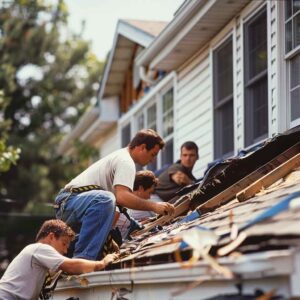Are you curious about composition roofing? Well, look no further! In this article, we’ll explain everything you need to know about this popular roofing option.
From its definition and materials to its advantages and factors when choosing, our expert roofers have got you covered. We’ll also discuss maintenance and longevity so you can make an informed decision for your home. Stay tuned for all the essential information on composition roofing!
Composition Roofing: Definition and Materials
What makes up composition roofing? It is a type of roofing that is made up of a blend of materials, including asphalt, fiberglass, and other additives.
There are various types of composition roofing available in the market, each offering different benefits and costs. The most common types include asphalt, fiberglass, and architectural shingles.
Asphalt shingles are the most affordable option, making them popular among homeowners.
They are resilient and available in a broad spectrum of colors and styles.
Fiberglass shingles, on the other hand, are lightweight and fire-resistant. They have a reputation for delivering outstanding performance in challenging weather conditions.
Architectural shingles are a premium option, offering a more dimensional appearance and enhanced durability. With an extended lifespan, they can replicate the appearance of alternative roofing materials such as wood or slate.
Regarding cost comparison, asphalt shingles are the most budget-friendly, while architectural shingles tend to be more expensive. Fiberglass shingles fall somewhere in between.
When selecting the appropriate composition roofing material for your home, it’s crucial to take into account both your budget and the desired aesthetic.
Advantages of Composition Roofing
One significant advantage of composition roofing is its versatility, making it a popular choice for homeowners.
Here are three reasons why composition roofing is advantageous:
1. Cost-effectiveness: Composition roofing is cost-effective when compared to other roofing materials like wood or slate. It provides exceptional value for your investment without compromising on quality and durability.
2. Eco-friendly options: Many composition roofing materials are made from recycled materials, reducing waste and promoting sustainability. Additionally, some composition roofs are designed to reflect sunlight, reducing energy consumption and making your home more environmentally friendly.
3. Low maintenance: Composition roofing requires minimal maintenance, saving you time and money in the long run. Due to its resistance to rot, mold, and mildew, composition roofing can endure severe weather conditions, making it an optimal choice for homeowners in search of a low-maintenance roofing solution.
Factors to Consider When Choosing Composition Roofing
When choosing composition roofing, consider the factors that will impact your decision. Two critical factors to consider are cost considerations and environmental impact.
In terms of cost, composition roofing is generally more affordable than other roofing materials.
Nonetheless, the exact cost will be contingent on factors such as the size of your roof, the intricacy of the installation, and the quality of the materials employed.
Evaluating your budget and determining what you can afford carefully is essential.
Additionally, composition roofing has a lower environmental impact than other roofing materials.
Frequently crafted from recycled materials, it can also be recycled at the conclusion of its lifespan. This makes it a more sustainable choice for environmentally conscious homeowners.
Maintenance and Longevity of Composition Roofing
To ensure the longevity of your composition roofing, regular maintenance is essential.
Proper care and attention can help prevent common issues and extend the lifespan of your roof. Here are some maintenance requirements and common issues to be aware of:
1. Regular inspections: Schedule annual inspections to identify any potential problems, such as loose or missing shingles, damaged flashing, or signs of water damage.
2. Cleaning: Keep your roof clean by removing debris such as leaves, branches, and moss. This will prevent moisture buildup and potential damage.
3. Repairing and replacing: Promptly address any issues, such as cracked or damaged shingles or flashing. Repair or replace them to prevent further damage and maintain the integrity of your roof.





